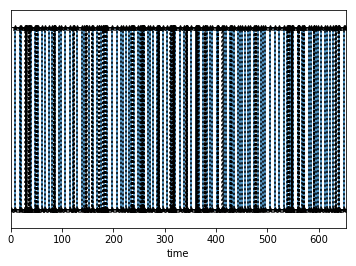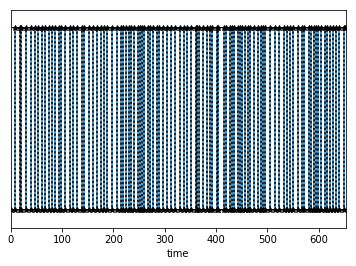Time series¶
%matplotlib inline
Just checking the logic.
import matplotlib.pyplot as plt
from dcprogs.likelihood import plot_time_series
from dcprogs.likelihood.random import time_series as random_time_series
perfect, series = random_time_series(N=100, n=100, tau=1)
print(perfect)
fig, ax = plt.subplots(1,1)
plot_time_series(perfect, ax=ax)
plot_time_series(series, ax=ax, marker='*', color='k', linestyle=':')
[ 0. 8.94723321 17.58625122 20.91738707 30.20777201
39.32092447 46.79161468 52.77685434 61.48455584 67.44456259
74.100705 81.16816666 86.41390341 93.2990448 98.32441428
105.58728546 114.71226183 121.79759018 128.39316551 137.89193074
143.38102535 152.56225579 160.16272388 167.17517573 175.01513147
180.92863655 188.3360409 197.29145568 206.70028088 213.93436107
218.10289559 224.6773545 230.09537989 233.76001015 240.67886355
247.87099605 251.756665 255.63396464 260.34412052 267.56884572
271.05676428 276.28833648 285.1861875 288.87919303 296.47228537
304.46016273 312.91504567 320.69227562 328.90975232 337.32091015
342.86258197 351.00318569 359.85877781 362.9354895 366.49640284
374.80184694 382.90380628 388.63786471 392.28760556 401.04635203
404.57265817 414.50588183 419.35422088 426.84891827 430.39730468
435.1928332 442.92866593 446.46914111 450.29317602 455.83836839
461.27886045 465.35700447 474.47964825 482.3700017 487.15319401
491.89688188 495.74211533 504.51676039 513.93686707 522.20488861
531.23128829 537.67515504 543.47407658 550.50406751 558.884036
568.0541782 571.76171722 581.04217683 584.39539916 591.43409644
594.51307274 597.64494175 603.90633403 612.42260853 615.74390755
621.16093995 627.8050522 634.23335659 639.03347348 648.10262786
651.84007882]

from dcprogs.likelihood import time_filter as cpp_time_filter
filtered = cpp_time_filter(series, 1)
fig, ax = plt.subplots(1,1)
plot_time_series(perfect, ax=ax)
plot_time_series(filtered, ax=ax, marker='*', color='k', linestyle=':')

Now, computes the likelihood of this time series for a random QMatrix